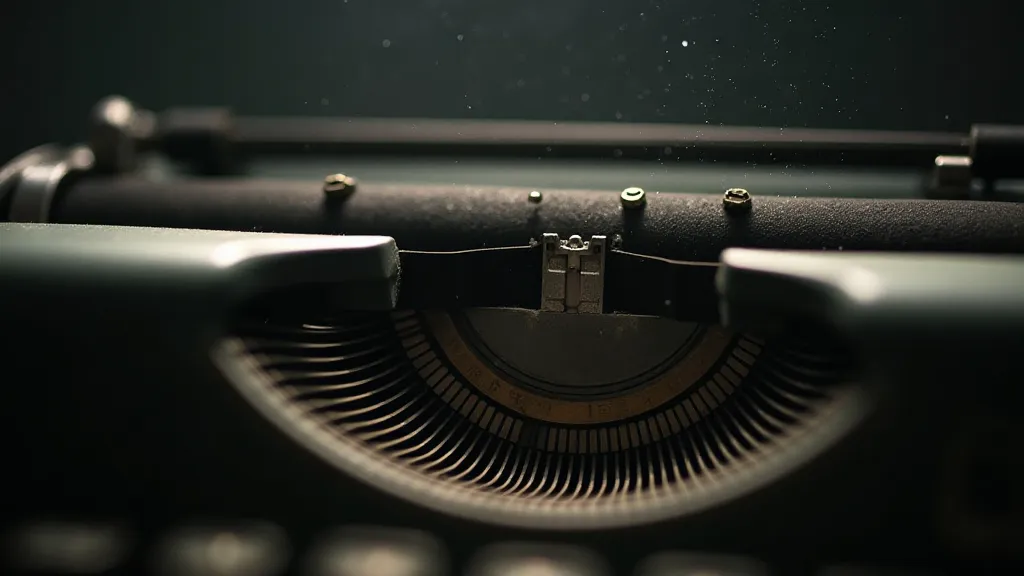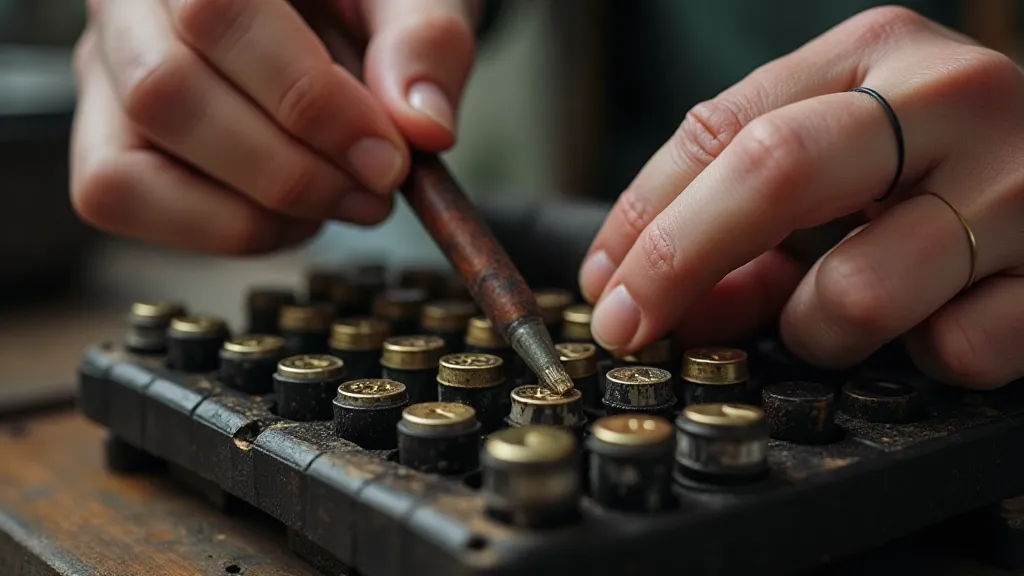The Legacy of the League: Understanding the Remington and its Influence
There's a peculiar romance in the clatter of keys, a tangible connection to a time when words weren't conjured by invisible electrons but painstakingly hammered onto paper. For those of us drawn to antique typewriters, that romance often begins with the Remington. It wasn’t the first typewriter, certainly, but it was undeniably the one that brought the concept to the masses, etching itself into the very fabric of how we communicate. To understand the world of antique typewriters, to truly appreciate their restoration and collecting, is to understand the legacy of the Remington.
My first encounter with a Remington wasn't in a museum or antique shop, but tucked away in my grandfather's dusty attic. He's a man of few words, my grandfather, but his silence speaks volumes about the objects he keeps. This particular Remington No. 2, dating back to the late 1870s, wasn’t pristine. The paint was chipped, the keys sticky, and a faint aroma of old ink permeated the air. But in that moment, holding it in my hands, I felt a profound sense of connection. It wasn't just a machine; it was a portal to a different era, a testament to ingenuity and perseverance.

The Birth of a Revolution
The story of the Remington typewriter begins, surprisingly, with E. Remington and Sons, a company primarily known for manufacturing firearms and sewing machines. After the Civil War, seeking to diversify their business, they began exploring various inventions. Christopher Latham Sholes, Carlos Glidden, and Samuel W. Soule, inventors who had previously been working on a writing machine, were brought on board. Their initial designs were far from the sleek machines we now associate with the name, but they represented a crucial first step. The early models, like the Sholes and Glidden, were notoriously difficult to use, with a tendency to jam and a limited number of characters. The layout itself, a source of constant troubleshooting for early adopters, would later become the standard – a fascinating subject explored in more detail by enthusiasts charting the evolution of typewriter layouts. Understanding why these initial arrangements developed into the familiar QWERTY format, and the debates surrounding alternative designs, provides crucial context for appreciating the Remington's contribution.
Remington’s involvement proved vital. They brought a level of manufacturing expertise and marketing acumen that the original inventors lacked. The Remington No. 1, introduced in 1873, was the first commercially successful typewriter, though still a far cry from modern standards. It used a QWERTY keyboard—a deliberate design choice to *slow down* typists and prevent the type bars from jamming, a fascinating quirk in the history of technology. The QWERTY layout, initially a limitation, became the standard, a testament to its initial impact on adoption and use. The seeming randomness of the key placements often sparks curiosity, leading enthusiasts to delve deeper into the story of its design – a pursuit that sheds light on the practical challenges faced by early typists.
Craftsmanship and the Human Touch
Examining a Remington today, regardless of its condition, reveals a remarkable level of craftsmanship. These weren't mass-produced commodities in the modern sense. Each machine was assembled with a level of care and attention to detail that is rarely seen today. The cast iron frames are solid and robust, the brass components gleam with a warm patina (if well preserved, of course!), and the type bars, individually cast and precisely positioned, bear witness to the skill of the metalworkers. You can almost feel the hands of the craftsmen who meticulously shaped and assembled each component. Beyond the mechanical intricacies, the stories held within damaged mechanisms – the evidence of use and the silent cries of a frozen dialogue – offer a glimpse into the lives they touched. Enthusiasts often find themselves deciphering the language of these markings, piecing together fragments of the past. Each slight imperfection, each tell-tale sign of wear, speaks volumes about its journey through time.
Restoring a Remington isn't simply about replacing worn parts; it’s about preserving a legacy. It’s about understanding the delicate balance of the mechanism, appreciating the ingenuity of the design, and respecting the skills of those who built it. Finding original parts can be a challenge, often requiring scouring antique shops, online auctions, and connecting with fellow typewriter enthusiasts. But the reward—seeing a once-silent machine humming back to life—is immeasurable. The intricacies of a Remington's operation – from the escapement to the type bars – demand a deep understanding, and even experienced restorers occasionally encounter common jamming and sticking issues that require careful troubleshooting. Identifying the precise manufacturing period can be pivotal in sourcing correct components and understanding the machine’s operational characteristics – a detail that can often be determined by examining subtle markings and construction techniques.
The Impact on Writing and Society
The Remington typewriter didn't just change how we write; it profoundly impacted society. It democratized writing, making it accessible to a wider range of people. Prior to the typewriter, writing was a laborious process, often relegated to professional scribes. The typewriter empowered individuals—particularly women—opening up new career opportunities in offices and publishing houses. Suddenly, a broader spectrum of voices could be heard.
Consider Mark Twain, one of the first authors to submit a typewritten manuscript (Life on the Mississippi, 1883). He was famously skeptical of the technology at first, but soon recognized its potential. The typewriter became an essential tool for writers, journalists, and businesspeople, facilitating communication and accelerating the pace of innovation. Think about the legions of reporters sending dispatches from battlefields or the businessmen dictating letters to their secretaries; the Remington was often at the heart of it all. The precision and uniformity it brought to written correspondence transformed business practices and spurred a new era of mass communication.

Collecting and Restoration: A Labor of Love
For those captivated by the allure of antique typewriters, collecting Remingtons can be a fascinating, though sometimes demanding, pursuit. Early models are particularly prized, commanding high prices in the collector’s market. Condition is paramount; a machine in original, working order is significantly more valuable than one that has been heavily restored or damaged. However, even damaged machines hold a certain charm, offering a unique opportunity for restoration. Identifying the various markings and components – a veritable taxonomy of keys – is a key element of both collecting and restoration. Knowing exactly which manufacturing period corresponds to specific design features is critical, often requiring specialized knowledge and the ability to interpret subtle differences in construction and tooling – a skill which benefits significantly from understanding the intricacies of antique machinery dating practices. The ability to pinpoint a machine's age allows collectors to appreciate not just its beauty but also its place within the broader history of technological innovation.
Restoring a Remington is a process that demands patience, skill, and a genuine appreciation for the machine's history. It's not about achieving a flawless, museum-quality restoration. It's about preserving the character and integrity of the original machine. Replacing missing parts with reproduction parts is often unavoidable, but striving to use original components whenever possible is the mark of a true enthusiast. Learning to diagnose mechanical issues, cleaning and lubricating the type bars, and adjusting the escapement are all skills that can be acquired through practice and the guidance of experienced restorers. Understanding the nuances of identifying original versus reproduction parts also allows collectors to appreciate the subtle differences and potential pitfalls in the restoration process, adding another layer of appreciation for these iconic machines. Determining the age of a Remington is often the first step in any restoration project. Even seemingly minor details, like the style of the font or the type of metal used, can provide valuable clues about its manufacturing date. This deeper level of scrutiny transforms restoration from a mere mechanical repair into a historical investigation.

The Enduring Legacy
The Remington typewriter may no longer be the dominant force in the world of writing, but its legacy endures. It represents a pivotal moment in technological innovation, a time when machines began to transform the way we communicate. Holding a Remington in your hands is more than just handling a piece of machinery; it’s connecting with a history of ingenuity, craftsmanship, and the enduring power of words. And for those of us drawn to their quiet clatter and enduring charm, the legacy of the Remington continues to inspire. The machines stand as a testament to an era of innovation, a time when the clatter of keys signaled the dawn of a new age of communication. The Remington's contribution extends beyond the realm of writing; it represents a crucial chapter in the ongoing story of human ingenuity and the relentless pursuit of a more efficient and accessible means of expression. And as technology continues to evolve, the Remington's place in history remains secure, a reminder of a time when the simple act of typing held a profound significance. The remarkable journey from a specialized industrial tool to a ubiquitous writing instrument highlights not only the evolution of technology but also the enduring human desire to communicate effectively and creatively.





